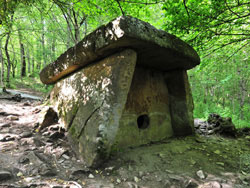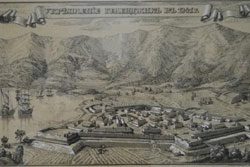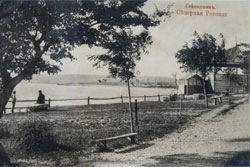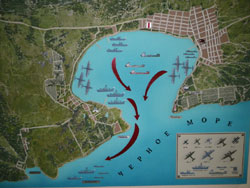


History of Gelendzhik
Caucasus Black Sea coast has been inhabited since the earliest times. On certain sites of modern coastal towns and villages traces of ancient settlements were found.
Six kilometers from Gelendzhik, on the eastern edge of settlement Svetly, archeologist V.E.Shchelinsky in 1966 found an ancient encampment of Acheulian age. In 1990, during another survey of this memorial, a unique collection of stone artifacts was collected. The studied archeological material allowed to determine exactly the age of the ancient encampment, which was 100-120 thousand years. Many archeological finds including stone implements, household items, can be seen in Gelendzhik Historical Regional Museum.
Gelendzhik mid-Paleolithic settlement is the northernmost point of spreading of the Caucasian memorials of the Acheulian age.
 Tribes of the bronze age which lived 5,000 thousand years ago immortalized themselves by burial structures of stone slabs - DOLMENS (discovered in the end of the 19th century). These tombs were designed to guard the peace of forefathers eternally, they rival the forces of natures and the time itself.
Tribes of the bronze age which lived 5,000 thousand years ago immortalized themselves by burial structures of stone slabs - DOLMENS (discovered in the end of the 19th century). These tombs were designed to guard the peace of forefathers eternally, they rival the forces of natures and the time itself.
In the surroundings of Gelendzhik there is about a hundred of such memorials.
As burial structures the dolmens had been exploited until the 7-8th centuries AD. For unknown reasons, in approximately the first half of the second millennium BC their construction came to an end.
The period from 7th through 4th centuries BC entered history as the "Great Creek Colonization". Greek settlements arise on the northern and eastern coasts of the Black Sea. Towns were founded in those places where there were natural havens and fertile lands.
In the 6th century BC on the eastern coast of Tonkiy cape the Greek founded TORIK.
It was first mentioned by Pseudo-Scylax (4th century BC) in a section of the book "Description of the Sea Adjoining the Populated Europe, Asia, Libya" : "...Past the Sindi haven (Anapa) are the people kerkets. Past the kerkets are the people torets and the Hellenic town Torik with a haven".
Then the colonies were united into a single state known under the name of the Bosporan Kingdom. Panticapaeum (Kerch) became its capital. The Greek cities conducted active trade with local tribes: Scythians, Sindi, Maeotae. Both internal and external trade prospered. Active trade exchange required own coin to be introduced. Panticapaeum began pressing its own silver coin with an image of lion on its face.
 Torik was situated on the bustling sea trade route, which is evidenced by Panticapaean and Bosporan coins as well as fragments of ancient Greek vessels found on the coast of Gelendzhik Bay.
Torik was situated on the bustling sea trade route, which is evidenced by Panticapaean and Bosporan coins as well as fragments of ancient Greek vessels found on the coast of Gelendzhik Bay.
In 63 BC in the region of Gelendzhik a Roman port PAGRY arose. In the reserves of Gelendzhik Museum weapons, Roman and Bosporan coins characterizing this period are stored.
In the 3rd century AD many colonies of the Bosporan Kingdom perished under the thrust of Goths and other barbarous tribes. In the 4th century AD the most devastating blow on Bospor was delivered by the Huns, and the Bosporan State ceased to exist.
In the 6th century AD the positions of Byzantium were particularly strengthened in the North-Eastern parts of the Black Sea. As evidenced by early medieval authors, the Byzantine haven EPTALA was situated during that period in Gelendzhik Bay.
In the Middle Ages Genoese colonies started to appear in the Crimea and the Black Sea coast (according to medieval Italian maps - 39 colonies, settlements, and trading posts). Also the tribes of Zikhs lived here, thereafter their descendants, the Adyghe tribes of Natuqais and Shapsugs.
On the site of Gelendzhik in that period trading post MAVROLAKO was noted.
In the end of the 15th century the Black Sea coast of Caucasus fell under the influence of the Ottoman Empire. At that time Gelendzhik received its current name. According to one of the versions, it is translated from Adygei (Natuqais) as "a small clearing, pasture". Upon borrowing by the Turks the Adygei name might have acquired the form "Kelendzhik" which in translation from Turkic was interpreted by some researchers as "the little bride" and was accepted by the Russians as "GELENDZHIK".
For highlanders who did not have any internal market, Gelendzhik became the site of active bartering trade with the Turks. Turkish domination lasted for three hundred years.
Turkey and Russia would fight for possession of the Black Sea coast.
One of the Russian Turkish wars ended in the victory of Russia. September 2, 1829 by the Adrianople Treaty Russia gained the eastern coast of the Black Sea from the mouth of Kuban to the port of Saint Nicolas (north of Batumi). The conquered territories were fortified by protective military structures, a number of forts were founded.
 GELENDZHIK FORTIFICATION was founded in July 1831 by Major General Brekhman upon the Czar's order.
GELENDZHIK FORTIFICATION was founded in July 1831 by Major General Brekhman upon the Czar's order.
In 4-7 years Lieutenant General A.A.Velyaminov, the commander on the Caucasian line, in the course of expeditions along the coast founded the following fortifications: Aleksandriyskoye (Kabardinskoye) in 1836 and Novotroitskoye (Krinitsa) and Mikhailovskoye (Arkhipo-Osipovka) in 1837.
By 1839 the Black Sea costal line was built, to which all fortifications from the mouth of the river Kuban to the fort of Saint Nicolas (to the Turkish border) were subjected. It was being fortified for over twenty years and was to play its role in the attachment of Western Caucasus. But, falling short of expectations, it ceased to exist in 1854. During the Crimean War the fortifications of the Back Sea coastal line were blown up.
It was only after the end of the Crimean war, in 1864, that a great stanitsa (Cossack village) was founded in place of the fortress Gelendzhik, STANITSA GELENDZHIKSKAYA being part of the Shapsug coastal battalion. (From this moment on, the history of the current town Gelendzhik begins). After 1870 the great stanitsa Gelendzhikskaya was made a civilian community. It comprised 12 stanitsas including Pshadskaya, Berefovaya, Aderbiyevskaya, Vulanskaya (Arkhipo-Osipovskaya). The population consisted of resettling peasants of the internal provinces of Russia, Ukraine, Greeks and Armenians resettling from Turkey, and Czechs and Moldavians.
The mixed ethnic composition was a characteristic feature of the Black Sea coast.
In the beginning of the twentieth century, according to the author Konstantin Paustovsky visiting these places, "Gelendzhik was then a very dusty and hot townlet without any vegetation. Only prickly bushes of Christ's-thorn and chakhlai with yellow dry flowers grew in front yards". Nevertheless, the sea climate already attracted quite a lot of vacationers.
 The coastal line was gradually developed. Highways, roads, including a railroad branch to Novorossiysk were laid, which connected both the main population centers of the coast and the coast itself with Russia; a cement plant was constructed. Population centers were developed as resorts, attracting primarily middle layers of the Russian society such as teachers, physicians, petty and medium officials for a rest. The coast began to be advertized as an exclusively resort location.
The coastal line was gradually developed. Highways, roads, including a railroad branch to Novorossiysk were laid, which connected both the main population centers of the coast and the coast itself with Russia; a cement plant was constructed. Population centers were developed as resorts, attracting primarily middle layers of the Russian society such as teachers, physicians, petty and medium officials for a rest. The coast began to be advertized as an exclusively resort location.
A rural community was formed in Gelendzhik which allocated empty land lots for construction of summer cottages. And by the beginning of the twentieth century, foreseeing the future of Gelendzhik as a good resort place, the far-seeing citizens acquired land from peasants for 25-50 rubles per lot, the cost of which would increase multiply.
From 1898 on, the first sanatoriums began to open for recreation and treatment.
On 15 July 1915 by the decision of the Council of Ministers of the Russian Empire GELENDZHIK was awarded the TOWN STATUS.
After the revolution, by 1920 a famous KURUPR, Gelendzhik-Novorossiysk Resort Authority, was formed. Not only the resort industry but also viniculture, maintain horticulture is developed in the region.
By the beginning of 1941 about thirty health centers operated in the region, in which over 50 thousand people were on recreation or underwent treatment annually, young pioneer camps started to appear.
 In 1942-43 Gelendzhik becomes a front-line town, a base of the ammunition and materials supplies of the Novorossiysk group of the Soviet troops.
In 1942-43 Gelendzhik becomes a front-line town, a base of the ammunition and materials supplies of the Novorossiysk group of the Soviet troops.
The town became a large military hospital.
In the years after the war many sanatoriums were reconstructed, some health centers were expanded, changed their profile, their throughputs increased abruptly.
From 1970 Gelendzhik became a resort of national significance.
The 90th years of the twentieth century, the years of perestroika and trials, stopped the development of the town as a resort. Sanatoriums and recovery centers became empty, park and alley lanes hid in grass and dilapidated, everything around would frighten people by grayness and gloom.
The modern resort Gelendzhik underwent considerable changes, making a breakthrough in its development. The green and flowering resort gladdens with the waterfronts executed in a single architectural style, well-groomed beaches of settlements and the developed infrastructure of the town. The assortment of offers for the residents and guests of the town is quite various.
Each of the settlements which was part of Gelendzhik district had its specific historical events affecting, in one way or another, the destiny of each particular location. It may be the name of the site, such as Arkhipo-Osipovka, to commemorate the feat of the Russian soldier of the 77th Tenginsk regiment Arkhip Osipov during the Caucasian war, or the presence of known personas such as L.I.Brezhnev in Maryina Roshcha.
But each settlement should be given a brief and ordered summary.
Village Kabardinka.
It is situated 13 km from Gelendzhik on the coast of the Tsemess bay. On south west Kabardinka is sheltered from winds and storms by the Doob cape extending far into the sea. On north east it is protected by the offsets of the Markoth ridge.
Kabardinka is the driest place even among the more southern Black Sea regions.
Originally named Aleksandriysky (1836) in the honor of the then ruling Empress, this fort was soon renamed Kabardinsky (by the name of the regiment quartered here). The Decembrist poet Aleksandr Bestuzhev Marlinsky exiled here after the Siberian hard labor, worked in the construction of the fort and the road. After completion of the construction he gained a non-commissioned officer rank and was enlisted in the garrison of Gelendzhik fortification.
In the beginning of its existence the inroads of highlanders in the Kabardisnky fort were frequent. But after the relations with local people improved, two peaceful villages Aduao (60 households) and Khabady (50 households) were included in it. After the Caucasian war part of the unconquered highlanders were evicted to Turkey, in their stead Greeks, retired Cossacks and soldiers came to develop the empty lands. In the 1920s the former best summer cottages were transferred under the control of the Resort authority
During the Great Patriotic War Kabardinka was the closest settlement to the front line, within 20 km. Behind Kabardinka the troop of Captain A.E.Zubkov was deployed, its naval guns supported the defenders of the Small Land with fire. The sight shooting of the troop did not allow the enemy to make use of the port and remained an inaccessible boundary. For almost a year these positions were severely shelled by the German guns from sea, land, and air. The heroic defense of this battery played an important role in the fighting for Novorossiysk and the coast. The settlement was almost completely destroyed, and after the war it was rebuilt very slowly. It is only by the end of the 1970s when a gas pipeline was laid here, that kerosene lamps fell out of use. Then the settlement was developed as a children's resort, creating the reputation of a "children's republic".
South of Kabardinka there is a small village Maryina Roshcha. Here in the years of the Great Patriotic War the headquarters of the 18th paratrooper force was deployed, the commander of which was Lieutenant General K.N.Leselidze, and the head of the political department was Colonel L.I.Brezhnev, the future General Secretary of the Central Committee of the CPSU.
Village Divnomorskoe.
It is situated on the opposite side from Kabardinka, approximately at the same distance on the sea cost, south east of Gelendzhik.
The village is near two rivers, Mezyb and Aderba flowing into it. Earlier at this site there was an Adyghe village Mezyb (richly wooded), then the settlement had for more than 100 years the name False Gelendzhik. Probably, that was because sailors often mistook this small bay for Gelendzhik bay, casting anchors here, hiding from acts of elements on a quite haven. In 1964 the village was renamed Divnomorskoye. From here along the sea toward Dzhankhot extends the magnificent grove of the Pitsunda pine. The sea is clear, it becomes warm early in the year, the bottom is sandy in shallow waters. It was here that in the very beginning of the twentieth century the second sanatorium in the region "Sine More" was established.
Dzhankhot and Praskoveyevka.
The settlement Dzhankhot is situated in a small, horseshoe-like and very picturesque cove. It is unique for being located in the largest massif of the rare Pitsunda pine. Marine bluff coast in its surroundings with rare slopes (coast height up to 50m sometimes), giant pines, the sea, air, and quietness impart a particular color to the settlement. It is known for both the beauty of its sites (The Big Blue) and the historical country estates (the memorial museum house of V.G. Korolenko and the summer cottage center of F.A. Shcherbina).
Translated from Adygei, "dzhankhot" means "born in a shirt" (a lucky one, minion of fortune). As the legend runs, the name of the settlement is related to the name of the Circassian prince Dzhankhot renowned for his hospitality. He gave shelter to highlanders who fled their village from vendetta.
Upon the end of the Caucasian war highlanders were evicted to Turkey, and many years later, only by the end of the 19th century, being gradually populated, the settlement turned into a resort. It was founded by the brothers F.A. and K.S. Shcherbinas who had bought out a land lot and, following the tradition of the time to give beautiful names, poetically named their estate Dzhankhot. After which the entire small settlement was called the same name.
By an invitation of F.A. Shcherbina, Dzhankhot was visited by the humanitarian author V.G. Korolenko who called these sites "a basket of herb". The writer drew the sketches of his future cottage by himself. The cottage was annually improved, trees planted deliberately, they were carefully trimmed, new varieties were brought (such as apple transplants Renet Semirenko). His brother Illarion suffering from tuberculosis constantly lived in the cottage, who personally planted a most rare cedar of Lebanon 50 m from the cottage. In 1915 brother Illarion died, it is here, thereabout, that his grave is situated. And the author Vladimir Galaktionovich Korolenko never came to the cottage again, only reminiscing the quiet, fruitful years. In 1964 the cottage was restored, and the museum opened in it.
About 3 km along the sea coast from Dzhankhot, in the vicinity of the Praskoveyevka specialists claim that neither a cannonball nor a shell of the middle of the 19th century could break through the rock more than one meter thick). The height of the detached rock is 30m, the length 25m. Probably, the Sail rock is a section of a rock ridge once monolithic, that survived over many a millennium
Krinitsa.
Further south east of Gelendzhik, near the river Pshada, the settlement Krinitsa begins. It is separated from the village Beregovoye by a small mountain Shakhan.
Krinitsa appeared at the turn of the twentieth century as a community of intellectuals sharing the Populist ideas. The educated aristocrat V.V. Yeropkin acquired in 1886 a land lot in the vicinity of Mikhailovsky pass, giving it a name Krinitsa ("spring", "well"). At first the inhabitants of Krinitsa stayed in a house of four rooms. By 1900 there were 50 colonists already. Though, since the economic relations were not of primary importance, the matters in the community were not good. Viniculture saved the colonists from the ultimate bankruptcy. Gradually a community was formed of educated people with ideas to reform the society. Visiting the artel, V.G. Korolenko was impressed with the moods and enthusiasm of the colonists. Later the community lost its ideological roots and transformed into a successful agricultural cooperative. The founder Yeropkin promulgated the experience of the community, strengthening its economic principles far from Krinitsa. It is only when he was paralyzed that he was brought to his home estate where he soon died. Krinitsa was preserved for a long time as a profitable farm yard.
Betta.
The settlement is situated several kilometers from Krinitsa, 300 m from the sea and 20m above its level.
Translated from Adygei "bete" means hunchbacked. The settlement received its name before the revolution. It was founded by miners. Having arrived from central and southern provinces of Russia, the laborers expected to secure occasional earnings here. Love of labor, mild climate, good lands, and a desire to set up households allowed the laborers to start community life. Local population and intellectuals having a summer rest helped them with advice.
The Shirochanskaya artel appeared with the efforts of which gardens, vineyards, and arable land were cultivated. Beta is one of the richest sites in vegetation resources of Gelendzhik district.
Arkhipo-Osipovka.
The settlement is the farthest one from Gelendzhik, 50 km to the south.
On three sides it is surrounded by mountains, cut through with the rivers Vulan and Teshebs disgorging into the sea. Numerous traces of ancient settlements, dolmens, and burial mounds are discovered here.
The settlement received the current name to commemorate the valor of a Russian soldier.
After the end of the Russian Turkish war, the construction of forts, and reinforcement with them of the coastal line, the encounters and enmity in the Caucasus continued. In 1840 the highlanders, having taken the Lazarevskoye and Velyaminovskoye fortifications with large numbers, were attacking Mikhailovskoye. Three times the defenders repelled attacks, but the forces were unequal: 500 soldiers of the garrison were fighting with 11 thousand mounted and unmounted highlanders. When the battle shifted to the barracks and powder casements, Arkhip Osipov threw a burning brand into a powder casket. The powerful explosion shattered the attacking highlanders and the handful of the defenders. Some, wounded and contused, were captured, escaped, and told of the soldier's feat.
The Mikhailovskoye fortification was not restored after its defeat. After the Caucasian war a Cossack village Vulanskaya appeared here.
The villagers set the first monument to a regular soldier in Russia, which was a large chiseled white cross seen from the sea. In the foundation of the monument on a metal plate a dedicatory inscription is embossed.
In 1889 the stanitsa Vulanskaya was renamed into Arkhipo-Osipovka.
For a long time Arkhipo-Osipovka remained an out-of-the-way village.
In the beginning of the twentieth century Arkhipo-Osipovka began to gradually acquire the characteristics of a resort settlement.






